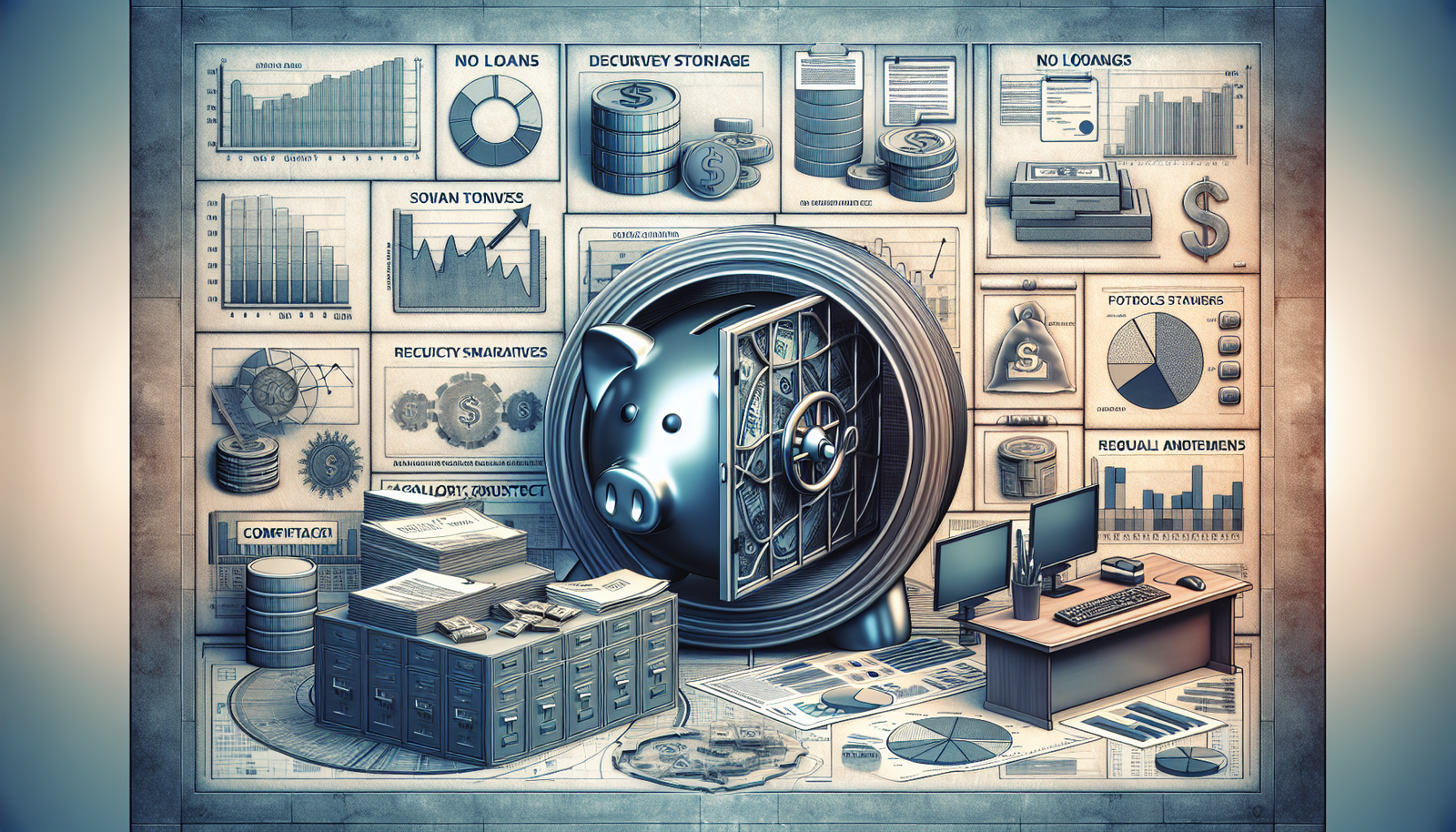
Imagine being told to step right into the world of paradox, where the unexpected is the norm — a world where banks don’t lend money. Yes, in this enchanting realm of financial curiosities, your conventional understanding of banks as money-lending institutions is thrown out the window. You’re about to explore these unconventional banks, unravel why they don’t loan money, and understand the affecting mechanisms that influence their operations. Brace yourselves to peel back the layers of the finance industry and upset the apple cart of your previous banking knowledge. No loans, no debts, simply an unusual banking dance — prepare yourself for a financial tradition turned on its head.

Understanding Banks That Don’t Loan Money
Welcome to the curious world of banking. Here, there are entities that exist as banks, but contrary to what you might expect, they do not loan money. Although this might sound perplexing, these banks are an integral part of the global financial infrastructure.
Concept of non-loan banking
Non-loan banking is essentially banking devoid of one of its main functions – lending money. These banks operate by providing a variety of services but stave off the lending aspect. They offer all the other facilities, such as safekeeping of valuables, financial transaction services, and advisory services.
Types of such banks
Labels might differ, but, fundamentally, there exist such entities like investment banks, payment banks, and custodian banks which exemplify banks that don’t loan money. While investment banks are focused on trading, underwriting, and mergers & acquisitions services, payment banks offer transactional services without lending. Custodian banks offer safekeeping services.
Functioning of these banks
Non-loan banks function by offering a range of services aimed at asset management, transactions, and financial advisory. They focus on catering to specific needs of their clientele, maintaining a narrower customer base, and yet, delivering personalized and efficient service. They revolve around risk-averse business models and rely heavily on maintaining customer trust.
Reasons Banks Might Not Loan Money
Humans and institutions have tried to foretell the future. Banks follow a similar route when it comes to loaning money.
Assessment of credit risk
As a banker, you know that the risk of customers not being able to repay a loan (credit risk) is a constant fixture. To mitigate this, banks have credit assessment systems, which meticulously examine an individual’s financial history. If the risk is high, the bank might refrain from issuing loans.
Regulatory constraints
You operate within a framework set by the regulatory bodies, which may sometimes restrict your capability to dispatch loans. If the risk associated with lending overshadows the potential returns, regulatory compliance might hinder loaning procedures.
Economic instability
You are aware of how vulnerable the banking sector can become during periods of economic instability, such as recessions or depressions. During such times, banks can actively choose to reduce or suspend their loaning activities to avoid accumulating bad debts.
Insufficient capital
banks need capital to ensure that they can cover losses while still honoring withdrawals. If a bank has low capital resources, it might hold off on lending money.
Non-Loan Services Offered by Banks
Banks that don’t loan money flourish in their own right by offering a platter of tailored services, propelling the banking sector into new frontiers.
Transaction services
You will find these banks offering services catering to transactions, providing hassle-free and speedy dealings. They focus on technology-intensive services, offering mobile and internet banking facilities to ease your transactions.
Advisory services
Banks not indulging in loan services often extend financial advisory services. They offer advice pertaining to investments, tax planning, and wealth management.
Safekeeping services
Much like a trustable friend, these banks extend safekeeping services. They safeguard your valuables, securities, and documents, offering peace of mind.
Asset Management
Non-loan banks tend to venture into asset management, offering consulting services to aid you in strategic allocation of your assets to maximize returns.

Processing and Application for Non-Loan Banks
Setting up an account
To avail the services of non-loan banks, you must start by setting up an account. The process is simple and straightforward, involving document submission, consent to their terms and conditions, and deposit of a minimal account opening balance.
Procedure for accessing services
Post-account setup, you will be oriented on how to access their services. This includes familiarizing you with their digital platforms or guiding you through their in-person services.
Document requirements
The documents required usually include proof of identity, proof of address, and in some cases, income credentials. The specification varies based on the specific bank and its line of services.
Comparative Analysis: Banks With Loans Vs. Banks Without Loans
Comparing the business models
Banks that loan money operate on interest income, whereas non-loan banks earn from service charges, fees, or commissions. The models differ vastly, affecting the risk and diverse customer base.
Understanding the risk factor
Non-loan banks are safer operations, given that they avoid bad debt and risks related to credit default. However, loaning banks earn higher returns by assuming the intricacies of credit risk.
Impact on customer behaviour
The perception of customers toward risk, interest rates, and return on investment may influence their choice of the banks. Customers engage with non-loan banks due to their niche services and dependability.
Risk Management in Non-Loan Banks
Overview of risk management
Risk management in non-loan banks focuses on operational risks, cyber-risk, and reputation risk, among others. This involves setting processes in place to mitigate potential default situations.
Potential risks and their management
Operational risks stem from inadequate or failed processes, human errors, or system malfunctions. Cyber risks involve protection against online fraud. Reputation risks revolve around maintaining customer trust. Regular audits, quality checks, and embracing technological advancements are some ways to manage these risks.
Role of regulatory bodies
Regulatory bodies influence the operations of non-loan banks, endorsing transparency, ethical conduct, and customer-centric practices. They also play a pivotal role in reinforcing stability within the banking sector through effective risk management regulations.
Advantages of Banks that Don’t Loan Money
Benefits for customers
Customers benefit from specific, personalized services, less exposure to financial risks, and potentially improved customer service due to the narrower client base of non-loan banks.
Less risky operations
No lending translates to no possibility of bad debts, leading to less risky operations and stable income flows through fees and services.
Efficiency in service provision
Specialization in niche segments leads to superior service provision in those areas. Customers may appreciate the directness and tact, resulting in increased customer satisfaction.
Disadvantages of Banks that Don’t Loan Money
Limited services
Non-loan banks might be criticized for their limited scope of service. Customers expecting diverse services within a single banking relationship might prefer a bank that loans money.
Reduced customer base
The niche offerings may result in a limited customer base. As many customers engage with banks for lending operations, non-loan banks may see a lower customer reach.
Impacts on economy
By not providing loans, these banks do not directly stimulate economic growth, which lending banks do through business and personal loans.
The Future of Non-Loan Banking
Predicted trends
The future beholds an ascending trend for non-loan banks. As customers seek specialized services and the uncertain economic climate prevails, these banks might see an upward trajectory with a surge in customer preference.
Impact of technology and digitization
Technology and digitization are imperative for the future growth of these banks. By embracing technology, they can enhance their reach, service delivery, and customer experience.
Regulatory changes and their effects
Changes in regulations, like data privacy laws and monetary policies, might shape the operations of these banks. They constantly need to adapt to the changing regulatory landscape to uphold their market position.
Real World Examples of Non-Loan Banks
Major non-loan banks worldwide
Non-loan banks exist extensively around the world. Some prominent names include Goldman Sachs, JPMorgan Chase, and Deutsche Bank in the sphere of investment banking.
Success stories
Goldman Sachs is amongst the largest investment banks worldwide, doubling-down on M&A and securities underwriting. JPMorgan Chase holds an impressive portfolio of investment banking services, contributing significantly to its overall success.
Challenges encountered and overcome
Non-loan banks face challenges like regulatory pressure, technology adoption, and managing threatened revenue streams. They have emerged victorious by embracing technology, delivering personalized customer experiences, and developing competitive strategies.

Leave a Reply